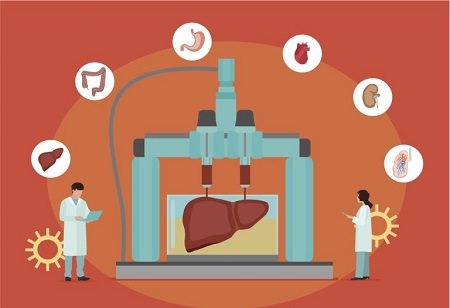Abhrasnata Das | Friday, 19 August 2022

The recent development of 3D bioprinting technology is revolutionary for the medical industry. It is a rapidly growing field that has been used for a wide range of biological goals. It differs from traditional 3D printing, which uses bioinks made of cells and other biomaterials to build intricate, functional tissues. Since bioink preparation, deposition, and print-out maturation are all involved, it is a complicated procedure.
Bioprinting also incorporates a variety of other factors, including the kind of printer used and the type of bioink used throughout the development process. It is widely utilized in the production of artificial three-dimensional tissue and organs, as well as stents for tissue engineering.
In not so distant time, 3D bioprinting is expected to gain significant market acceptance in the near future, primarily because of the growing demand for organ transplantation, expanding applications of 3D bioprinting in drug discovery and cosmetic surgery, and growing investments & funding in the field. According to a recent study by MarketsandMarkets, the global 3D bioprinting market is projected to grow at a CAGR of 26.5% during the forecast period (2016–2021), to reach USD 1,332.6 million by 2021. That being said, in this article let's look into the recent innovation in 3D bioprinting space.
Machine Learning Optimizing Bioprinting Procedure Bioprinting involves many components and various steps. The prediction of the outcome of bioprinting is extremely challenging without a workable computational model; thus, the optimization has been heavily dependent upon trial-and-error. Such empirical approaches can be emulated by machine learning. ML is a new paradigm for bioprinting. Although still in its infancy, ML has been used to address several key aspects of bioprinting.
ML models use computer algorithms to replace human data collection, analysis and determine a correlation. For example, bioprinting proceeds in three processing steps: pre-printing, printing and post-printing. Pre -printing pertains to the printing parameters, bioink selection, construct design, and environment setup that are essential to having an optimized deposition. ML can be applied here by incorporating data to determine the best printing conditions prior to printing. The integration of machine learning in the critical steps can assist in complex printing, shape fidelity, printing optimization, and tissue regeneration.
Advanced Skin Cell Models Our skin possesses significant regeneration properties, but its ability to heal wounds is not perfect and can lead to the formation of scars. Skin grafts using donor tissues currently remain the most effective treatment for large wounds, those caused by burns. Having said that, Novel 3D bioprinting technologies, which can precisely pattern the position of living cells, molecules and biomaterials to mimic the complex architecture of natural tissue, offer exciting new opportunities for the development of advanced cell models. It uses computer-aided design (CAD) model inputs to recreate burn damage layer by layer.
This method is being utilized to rebuild and grow cells from a patient’s own cells. It has transformed the medical industry while also paving the way for organ and skin tissue printing; thereby helping to improve the therapy by producing higher-quality skin grafts at a lower cost.
3D Bioprinting Strategies to Model Glioblastoma and the Blood-Brain Barrier Glioblastoma (GBM) is the most common and serious malignancy of the central nervous system. The brain’s unique biochemical and structural characteristics result in universal recurrence and poor prognosis. In vitro 3D models of GBM and Blood-brain barrier (BBB) utilizing patient- or healthy-individual-derived cells and biomaterials via 3D bioprinting technologies may replicate key physiological and pathological characteristics of GBM and BBB since traditional models fail to predict treatment effectiveness in GBM.
3D-bioprinted structures may be used as screening or drug delivery platforms to investigate the cellular and cell-extracellular matrix interactions in a species-matched, high-throughput, and repeatable way. 3D-bioprinted GBM and BBB models are presented in this research, with details on GBM and BBB microenvironmental compositions, appropriate biomaterials to imitate natural tissues, and bioprinting methods for model creation were studied. Overall, 3D-bioprinted GBM and BBB models are promising systems and biomimetic alternatives to traditional models for more reliable mechanistic studies and preclinical drug screenings, which could help to speed up GBM drug development.
Future With Bioprinting A rapidly growing industry, 3D bioprinting has the potential to improve animal and human healthcare. Advances in bioprinting have led to improvements in tissue vascularization, more precise bioprinters, and in vitro and in vivo tissue models. Despite the gap between societal promise and technological advancement, attention hasn't been paid much to the social and ethical issues related to 3D printing. On the other hand, 3D bioprinting technology has the potential to completely change how the human body is repaired or replaced. Despite this, issues such as universal access, equality, the responsibility of biology and engineering to operate in a manner similar to that of in vivo organs, as well as the ethical management of the process, object, and outcomes, continue to be raised.